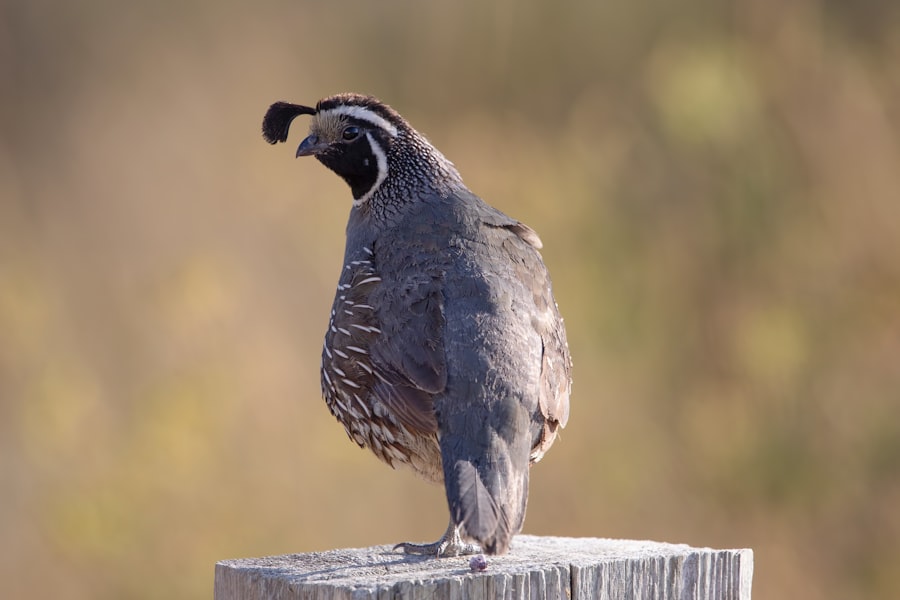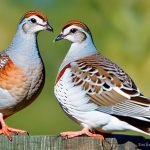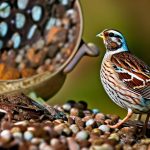Quails are small, ground-dwelling birds that are known for their social behavior and flocking tendencies. They are highly social birds and prefer to live in groups, known as coveys, which can consist of anywhere from a few to several dozen birds. Quails are also known for their foraging behavior, as they spend much of their time on the ground searching for food. They are omnivorous birds, meaning they eat a variety of foods including seeds, insects, and small plants. Quails are also known for their nesting behavior, as they build their nests on the ground and lay their eggs in shallow depressions lined with grass and other plant materials.
Understanding quail behavior is essential for effectively managing their feeding habits. By understanding their social tendencies, foraging behavior, and nesting habits, you can better tailor your feeding strategies to meet their specific needs. For example, knowing that quails prefer to feed in groups can help you determine the best feeder setup to accommodate their flocking tendencies. Additionally, understanding their foraging behavior can help you choose the right types of feed and manage feed distribution to ensure that all birds have access to the nutrients they need. By taking the time to understand quail behavior, you can create a feeding environment that promotes the health and well-being of your quail flock.
Quails are also known for their skittish nature and tendency to startle easily. This behavior is important to consider when designing a feeding system for quails. Loud noises or sudden movements can cause quails to become stressed and may disrupt their feeding patterns. By understanding this behavior, you can design a feeding system that minimizes stress and promotes a calm and natural feeding environment for your quail flock. Additionally, understanding their nesting habits can help you implement feed restrictions during certain times of the year to support breeding and nesting activities. Overall, understanding quail behavior is essential for creating a feeding system that meets the specific needs of these unique birds.
Key Takeaways
- Quail are ground-dwelling birds that prefer to forage and feed in low vegetation, so understanding their behavior is crucial for effective feeding.
- When choosing a feeder for quail, opt for one that is low to the ground and has a wide base to prevent tipping and allow easy access for the birds.
- Managing feed distribution involves placing feeders in areas with minimal disturbance and providing enough space for all quail to access the feed at the same time.
- Implementing feed restrictions can help prevent overeating and obesity in quail, leading to healthier birds and better egg production.
- Minimizing spillage is important to reduce waste and prevent attracting unwanted pests, so using feeders with built-in spill guards can be beneficial.
Choosing the Right Feeder
When it comes to feeding quails, choosing the right feeder is essential for promoting healthy feeding habits and minimizing waste. There are several different types of feeders available, each with its own advantages and disadvantages. Tube feeders, for example, are a popular choice for feeding quails as they can hold a large amount of feed and protect it from the elements. However, tube feeders may not be the best option for quails, as they prefer to feed in groups and may have difficulty accessing the feed from a single tube. Tray feeders, on the other hand, are a better option for quails as they allow multiple birds to feed at once and provide easy access to the feed.
In addition to the type of feeder, it’s also important to consider the size and placement of the feeder. Quails prefer to feed in groups, so it’s important to choose a feeder that can accommodate multiple birds at once. Additionally, placing the feeder in a quiet and sheltered area can help minimize stress and promote natural feeding behaviors. It’s also important to consider the height of the feeder, as quails are ground-dwelling birds and may have difficulty accessing feeders that are too high off the ground. By choosing the right feeder and carefully considering its size, placement, and height, you can create a feeding environment that promotes healthy feeding habits and minimizes waste.
Managing Feed Distribution
Managing feed distribution is an important aspect of feeding quails, as it ensures that all birds have access to the nutrients they need and helps minimize waste. One effective way to manage feed distribution is by using multiple feeders placed throughout the quail habitat. This allows all birds to access the feed without having to compete for limited resources. Additionally, placing feeders in quiet and sheltered areas can help minimize stress and promote natural feeding behaviors.
Another important aspect of managing feed distribution is monitoring feed levels and refilling feeders as needed. Quails have specific dietary needs, and it’s important to ensure that they have access to fresh feed at all times. By regularly monitoring feed levels and refilling feeders as needed, you can ensure that your quail flock has access to the nutrients they need to thrive. Additionally, monitoring feed distribution can help you identify any potential issues with feeder placement or design that may be impacting feeding habits.
Implementing Feed Restrictions
Implementing feed restrictions can be an effective strategy for managing quail feeding habits, especially during certain times of the year such as breeding season. During breeding season, it’s important to provide quails with a diet that supports their reproductive activities and nesting behaviors. This may involve implementing feed restrictions to ensure that quails are receiving the right balance of nutrients to support breeding and nesting activities.
One way to implement feed restrictions is by providing a specialized diet during breeding season that is higher in protein and other essential nutrients. This can help support egg production and chick development, while also minimizing waste by providing only the nutrients that quails need during this time. Additionally, implementing feed restrictions during breeding season can help promote natural foraging behaviors and encourage quails to seek out additional food sources in their environment.
Minimizing Spillage
Minimizing spillage is an important aspect of managing quail feeding habits, as it helps reduce waste and ensures that all birds have access to fresh feed. One effective way to minimize spillage is by choosing the right type of feeder that is designed to prevent waste. For example, tray feeders are a good option for quails as they provide a large surface area for feeding and help minimize spillage by containing the feed within the tray.
Another way to minimize spillage is by regularly cleaning and maintaining feeders to ensure that they are functioning properly. Over time, feeders can become clogged or damaged, leading to increased spillage and waste. By regularly cleaning and maintaining feeders, you can ensure that they are working as intended and minimize spillage.
Monitoring Feed Consumption

Monitoring feed consumption is an important aspect of managing quail feeding habits, as it helps ensure that all birds are receiving the nutrients they need and can help identify any potential issues with feeding habits. One effective way to monitor feed consumption is by regularly checking feed levels in the feeders and refilling them as needed. This allows you to track how much feed your quail flock is consuming and ensure that they have access to fresh feed at all times.
Another way to monitor feed consumption is by observing quail behavior during feeding times. By watching how the birds interact with the feeders and each other, you can gain valuable insights into their feeding habits and make any necessary adjustments to promote healthy feeding behaviors.
Adjusting Feed Rations
Adjusting feed rations is an important aspect of managing quail feeding habits, as it allows you to tailor their diet to meet their specific needs at different times of the year. For example, during breeding season, it may be necessary to adjust feed rations to provide quails with a diet that supports their reproductive activities and nesting behaviors. This may involve increasing the amount of protein in their diet or providing additional supplements to support egg production and chick development.
Additionally, adjusting feed rations can help prevent overfeeding or underfeeding, both of which can have negative impacts on quail health and well-being. By regularly assessing their dietary needs and adjusting feed rations as needed, you can ensure that your quail flock is receiving the right balance of nutrients to thrive.
In conclusion, understanding quail behavior is essential for effectively managing their feeding habits. By choosing the right feeder, managing feed distribution, implementing feed restrictions, minimizing spillage, monitoring feed consumption, and adjusting feed rations, you can create a feeding system that promotes healthy feeding habits and supports the well-being of your quail flock. By taking the time to understand their unique behaviors and dietary needs, you can create a feeding environment that meets their specific needs and promotes natural feeding behaviors.
If you’re looking for tips on how to keep quail from wasting food, you might also be interested in learning about the ideal coop size for chickens. Understanding the space requirements for your poultry can help optimize their environment and minimize food waste. Check out this informative article on how big a coop needs to be for a chicken to ensure that your feathered friends have the right amount of space to thrive.
FAQs
What are some common reasons why quail waste food?
Quail may waste food due to overfilling of feeders, poor quality or spoiled feed, inadequate feeder design, or stress-related behaviors.
How can I prevent quail from wasting food?
To prevent quail from wasting food, you can use feeders with smaller openings to reduce spillage, provide high-quality feed, avoid overfilling feeders, and ensure that the birds are not stressed.
What type of feeders are best for preventing food waste in quail?
Feeders with smaller openings, such as trough or tube feeders, are best for preventing food waste in quail. These feeders reduce spillage and make it more difficult for the birds to scatter or waste the feed.
What are some stress-related behaviors that can lead to food waste in quail?
Stress-related behaviors in quail, such as overcrowding, aggression, or fear, can lead to food waste. It is important to provide a low-stress environment for the birds to minimize these behaviors.
How can I ensure that quail have access to high-quality feed?
To ensure that quail have access to high-quality feed, store the feed in a cool, dry place to prevent spoilage, and regularly inspect the feed for signs of mold or pests. Additionally, provide a balanced diet that meets the nutritional needs of the quail.
Meet Walter, the feathered-friend fanatic of Florida! Nestled in the sunshine state, Walter struts through life with his feathered companions, clucking his way to happiness. With a coop that’s fancier than a five-star hotel, he’s the Don Juan of the chicken world. When he’s not teaching his hens to do the cha-cha, you’ll find him in a heated debate with his prized rooster, Sir Clucks-a-Lot. Walter’s poultry passion is no yolk; he’s the sunny-side-up guy you never knew you needed in your flock of friends!







